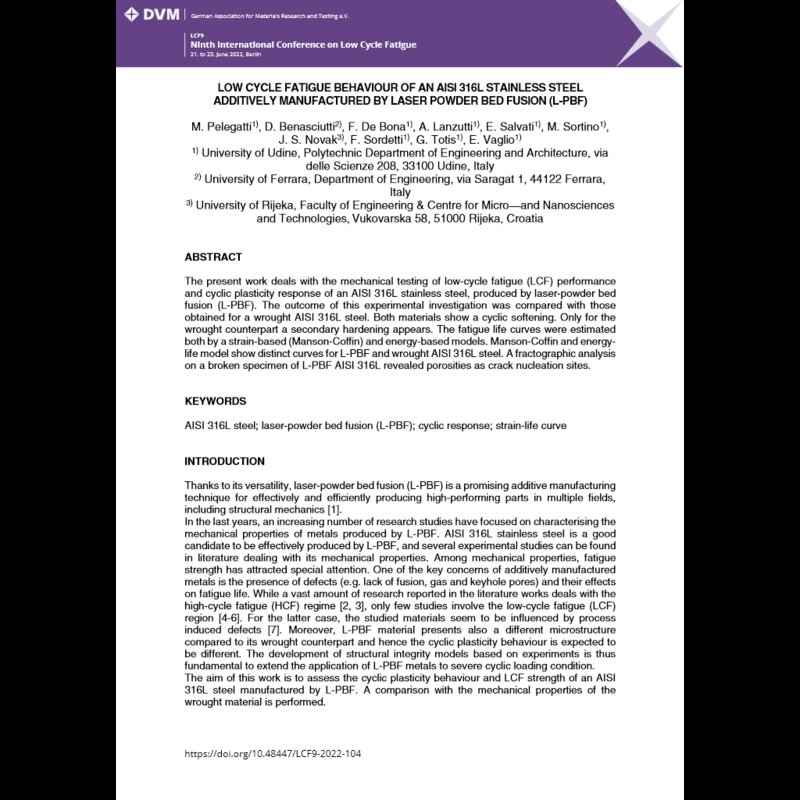- Nur online erhältlich



AISI 316L stainless steel is an ideal candidate when both high corrosion and resistance properties are sought. For this reason, it is of great interest to explore its behaviour also when obtained by additive manufacturing (AM) techniques. Particularly regarding the Low Cycle Fatigue (LCF) behaviour, that of the wrought material is well known (e.g. see Lim et al. Int. J. Fatigue 27, 1653–1660, 2005). However, when laser powder bed fusion (L-PBF) is used, experimental data are scarce and show low consistency (e.g. see Shrestha et al. Addit. Manuf. 28, 23–38, 2019 and Yu et. al. Mater. Sci. Eng. A 821, 141598, 2021). The aim of this work is thus to shed light on the cyclic response and LCF strength of an AISI 316L built by L-PBF. For this purpose, cylindrical specimens for both the…

Datenschutzbedingungen (bearbeiten im Modul "Kundenvorteile")

Lieferbedingungen (bearbeiten im Modul "Kundenvorteile")

Rücksendebedingungen (bearbeiten im Modul "Kundenvorteile")
AISI 316L stainless steel is an ideal candidate when both high corrosion and resistance properties are sought. For this reason, it is of great interest to explore its behaviour also when obtained by additive manufacturing (AM) techniques. Particularly regarding the Low Cycle Fatigue (LCF) behaviour, that of the wrought material is well known (e.g. see Lim et al. Int. J. Fatigue 27, 1653–1660, 2005). However, when laser powder bed fusion (L-PBF) is used, experimental data are scarce and show low consistency (e.g. see Shrestha et al. Addit. Manuf. 28, 23–38, 2019 and Yu et. al. Mater. Sci. Eng. A 821, 141598, 2021). The aim of this work is thus to shed light on the cyclic response and LCF strength of an AISI 316L built by L-PBF. For this purpose, cylindrical specimens for both the wrought and AM materials were tested at eight different strain amplitudes (i.e. 0.3%, 0.4%, 0.5%, 0.6%, 0.7%, 0.8%, 1%, 1.2%). AM samples were obtained by scanning bi-directional tracks melted in layers of 0.025 mm with a 0.12 mm laser beam moving at 600 mm/s and providing 180 W of power. The exposure pattern consisted of 5x5 mm alternating islands.
As shown in Figure 1, the AM material presents a cyclic hardening phase in the first few cycles, followed by a softening stage until failure. Conversely, for the wrought material the softening phase is followed by a significant secondary hardening, and its extent depends on the strain amplitude (see Pelegatti et al. Materials 14(13), 3588, 2021). This behaviour could be justified considering the initial microstructure and the deformation mechanisms. The wrought material exhibits a strain-induced martensitic transformation of the austenitic phase, whereas in the AM material the bi-phasic microstructure undergoes only the activation of dislocations (local micro-plasticity). Nevertheless, at each strain amplitude, the cyclic stress values of the L-PBF AISI 316L are almost always above those of the wrought material.
Considering the fatigue strength, no remarkable differences were detected between the two studied materials, regardless of the magnitude of the applied strain. A comparison of Manson-Coffin curves is presented in Figure 2. It can be noted that only at lower strain amplitudes the AM material shows a slightly reduced fatigue life compared to the wrought material. A fractographic analysis was also conducted on broken specimens to detect the discontinuities responsible for the crack initiation.